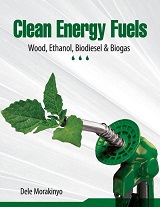
Environmental and Energy Business Resources
...everything environmental and energy...
Energy Friendly Transportation Modes
The largest sources of air pollution are power plants, industries and transportation (vehicle, train, cars and aeroplane) emissions
Transportation is a key component of our society. A considerable amount of energy is used to drive our transportation industry. All common transportation modes - road (using cars and buses), rail (using train), air (using aircrafts of different shapes and sizes) depend on fossil fuels to meet their tremendous energy needs. The fossil fuels release daunting amount of greenhouse gases into our atmosphere their polluting the atmosphere and contributing to global warming and its potential effects of flooding, drought etc.
Our modes of transportation, good and useful as they are, are also damaging our environment. May be we should start to walk and bike. Yes those are part of the solutions but how long will it take us to walk/bike from London, England to Sydney, Australia or from Johannesburg, South Africa to Copenhagen, Denmark. We may not be able to do that but there are ways to modify our transportation modes to reduce the amount of emissions we are releasing to the atmosphere very drastically. We need to be making environmentally-friendly lifestyle transportation choices to help reduce carbon emissions to our environment. Some of these choices are as outlined and briefly described below:
Walking: Walking, whenever and wherever you can, helps to eliminate the carbon emissions that would have been released to the atmosphere if you had taken a taxi or you drove. Additional advantages are that you save your travel costs and you get good cardiovascular workout, which saves you additional GYM money and makes you healthier. it has been said that an average pedestrian can walk 1 kilometre in 10 minutes. You ever wondered why many in developing countries do not go to GYM but they look fit and healthier than many people in the developed (or rich) world? An average person in the developing world walks at least 5 - 10 kilometres a day.
Cycling: Bicycle is the most efficient zero emission vehicle. The average speed for cyclists is 18 kilometres in an hour or 1 km in 3 minutes. You may need to learn how to ride a bike, but it is really not difficult. Biking contributes immensely to the reduction of greenhouse gases emissions to the atmosphere, saves you money and gives you good workout and healthier lifestyle.
Carpooling: A Car Pool is one driver plus one or more persons in the vehicle. If you regularly drive alone to and from work, drive with a friend or neighbour who normally drives alone. Rather than husband and wife taking different cars to work, go to work together and drop your spouse at his/her workplace before proceeding to yours (if you have the time). You could add your children drop-offs as well, if that could be accommodated. Taking these steps will help to cut your greenhouse gas emissions. Carpooling also reduces the number of cars on the road, so there's less traffic congestion and air pollution. Besides, some states have express lanes for carpoolers. Carpooling also saves you some money.
Mass Transit: A well organized City Mass transit system involving city buses or a combination of buses and trains will remove thousands of cars from the streets thereby reducing the amount of greenhouse gas emissions and helping the environment. Mass transit is effectively used in most part of Europe and some parts of North America. Emerging economies and developing nations should be encouraged to invest in Mass Transit.
Idling: Idling is the practice of keeping a vehicle engine running, without moving the vehicle. Excessive idling wastes an enormous amount of fuel and money and generates needless greenhouse gas emissions. Do not start your car until few minutes before driving off. Once a vehicle is warmed up, you should be ready to drive off. Continuing to run the engine while waiting (idling) waste lots of fuel thereby costing you more, and spoils the environment.
Use plug-in timer for all night plugging: The plug-in timer cuts the vehicle warming then vehicle is plugged overnight, thereby reducing energy usage and saving you money. Vehicles parked in garages may not need warming or require less warming (longer intervals between warming set in timer).
Tele/Video Conference rather than Flying Planes: For office meetings, if you can telephone or videoconference, you will save time, money, and carbon emissions. Airplanes pump carbon emissions high into the atmosphere, producing 12 percent of transportation sector emissions. Remote conference will also reduce air and road accidents saving lives.
Inflate your tires: If you own a car, it will get better gas mileage when the tires are fully inflated, so it will burn less gas and emit less carbon. Check your automobile monthly to ensure that the tires are fully inflated. You may be able to save 300 pounds of carbon dioxide for every 10,000 miles (or over 16,000 kilometres) you drive.
Biofuels - Consider using biofuels - biodiesel instead of the regular diesel and ethanol or ethanol amended fuels (e.g. E85) instead of pure gasoline. Follow the following link to learn more about biofuels - biodiesel and ethanol
Follow the links in the left pane to learn more on other Ways to cut down in energy usage:
Other websites of related contents:
Ten sure ways to save on your home energy bill and help reduce global warming
All Information on our website are free for your use. You are required to reference our website each time you use our materials. Please link back to: Environmental and Energy Business Resources using website address: http://www.environbusiness.com.

